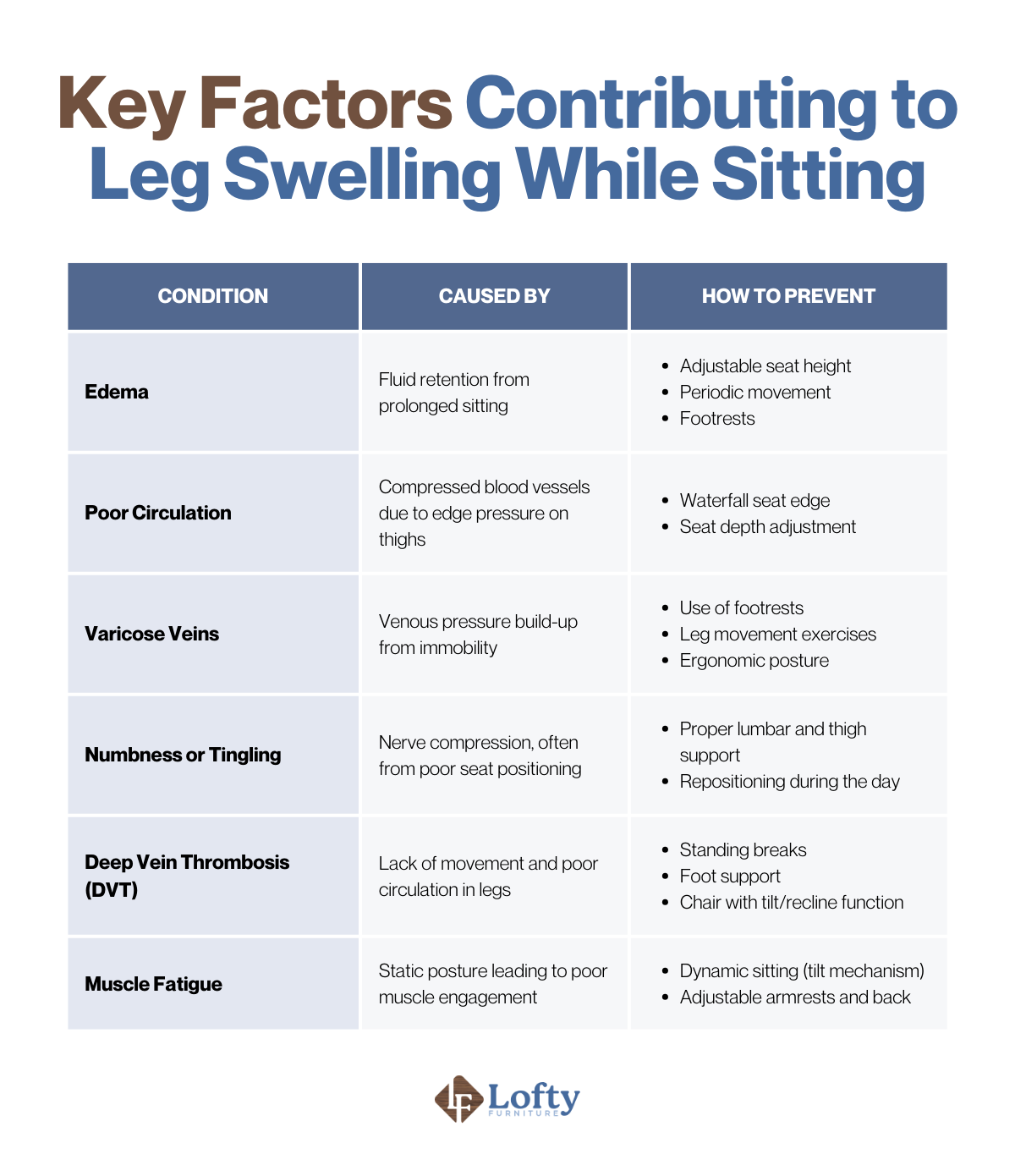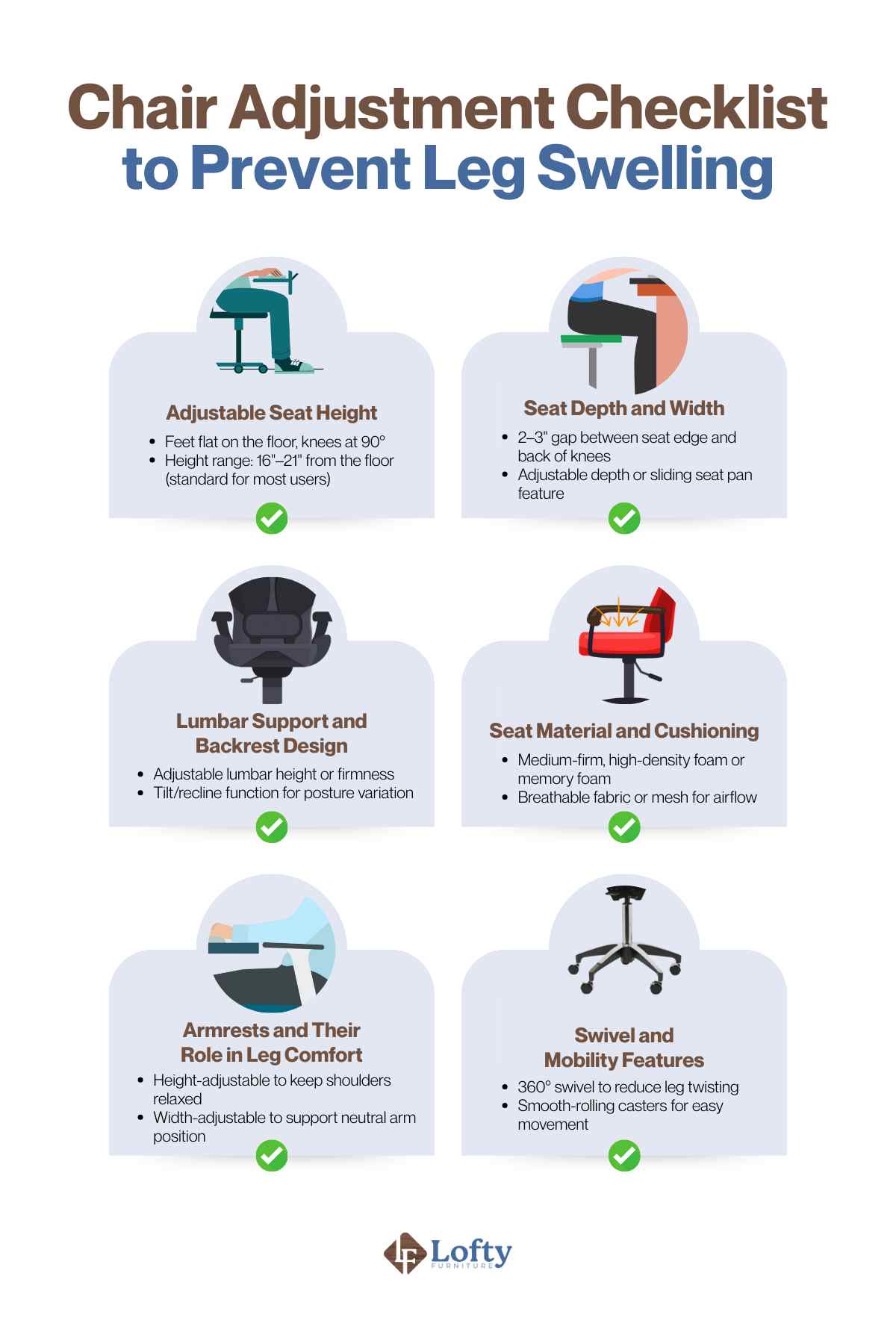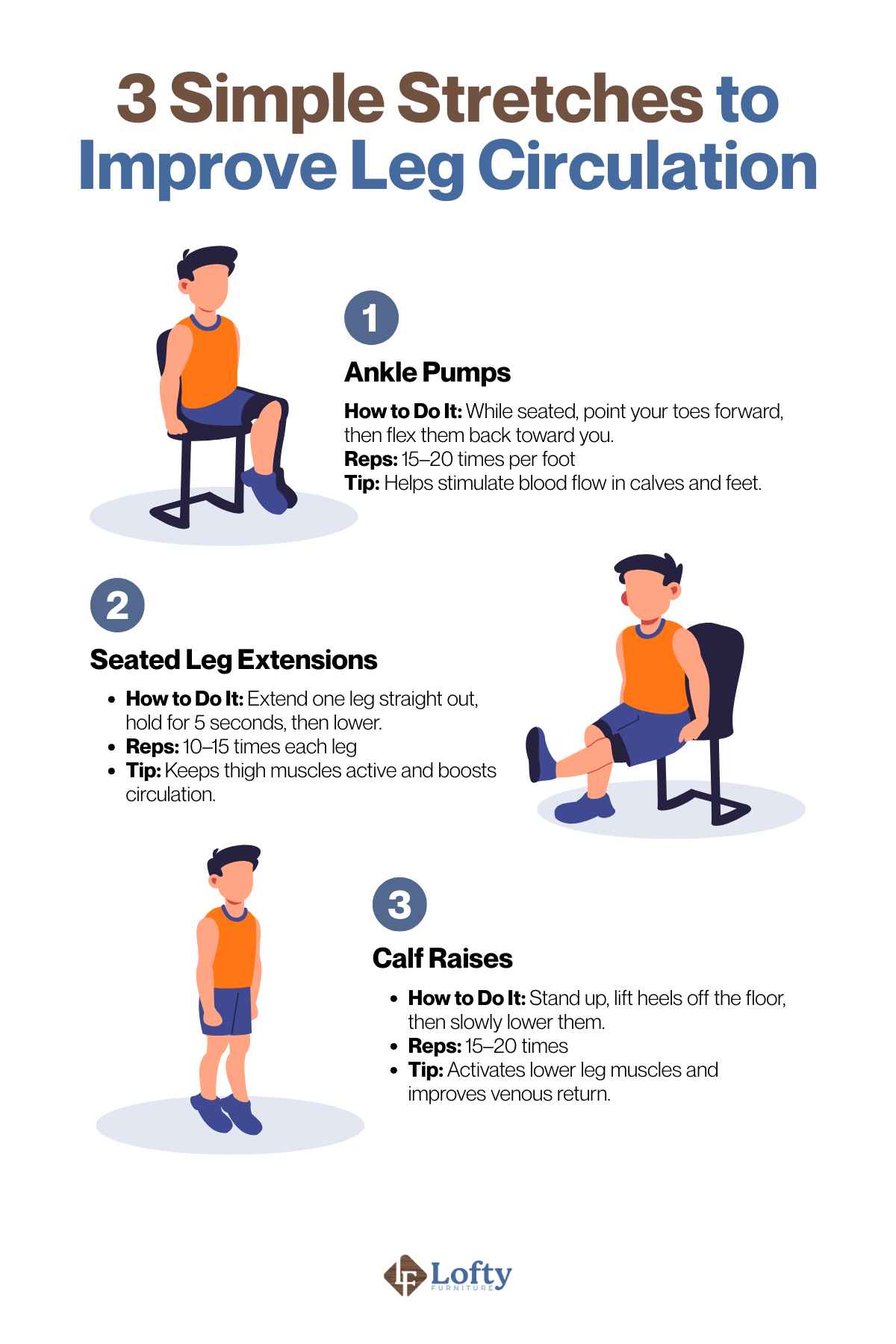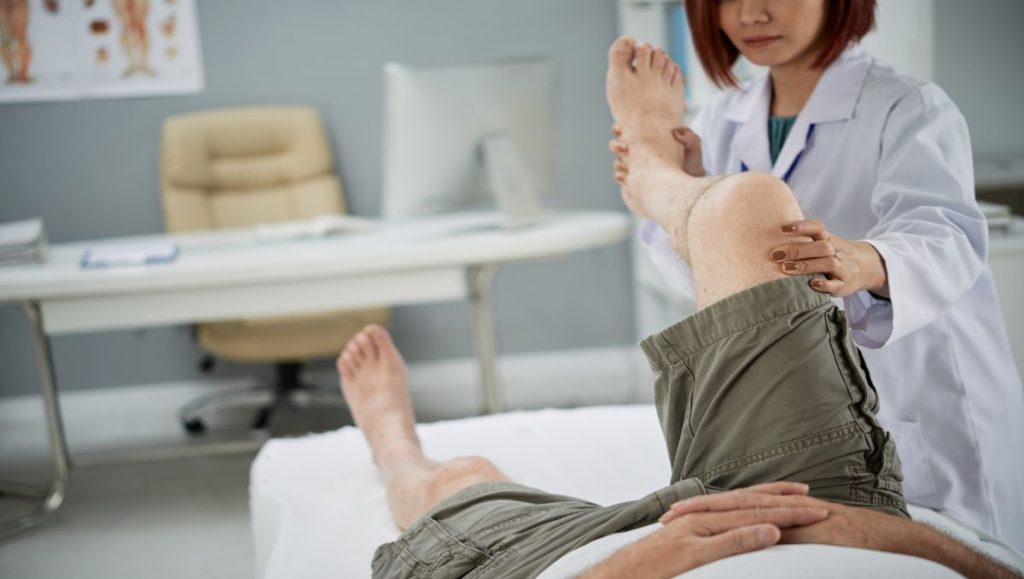If you’ve ever spent long hours at your desk, you know how quickly discomfort can set in. Whether it’s leg swelling, stiffness, or that constant ache, sitting for extended periods can take a toll on your body. Your office chair plays a huge role in preventing these issues. Choosing the right office chair to prevent leg swelling can make all the difference in promoting healthy circulation and supporting your posture.
Key Takeaways:
- To choose an office chair that prevents leg swelling and discomfort, focus on ergonomic features like adjustable height and depth, a comfortable seat cushion, lumbar support, and an adjustable backrest angle.
- Ensure your feet can be flat, avoid pressure behind knees, and consider breathable materials.
- Even with a good chair, stand, stretch, and adjust your posture frequently.
In this article, we’ll walk you through how to choose an office chair that not only prevents leg swelling and discomfort but also enhances your overall comfort throughout the workday.
The Link Between Sitting and Leg Swelling
Prolonged sitting has a direct impact on our circulatory and lymphatic systems, often leading to leg swelling, also known as edema. When we remain seated for extended periods, gravity pulls fluids down into our lower extremities. Simultaneously, the lack of leg muscle activity, which usually aids in pumping blood back to the heart, results in sluggish circulation.
Several factors can worsen leg swelling while sitting. Individuals with pre-existing circulatory issues, obesity, pregnancy, or those taking certain medications may be more susceptible. Additionally, poor posture, crossing legs, and wearing tight clothing can impede blood flow and exacerbate fluid retention. Research indicates that even brief interruptions to prolonged sitting, such as transitioning to a standing position or sitting Indian style, can help maintain electrical resistance in the body, likely preventing extracellular water expansion and ultimately reducing the risk of lower leg swelling.

Key Features of an Office Chair to Prevent Leg Swelling
Selecting a comfortable office chair with specific adjustable features can significantly improve your posture, circulation, and overall comfort. Here are the crucial features to consider.
Adjustable Seat Height, Depth, and Width
Ensuring your feet are flat on the floor or a footrest is paramount for maintaining proper circulation in your legs. When your feet dangle or are not fully supported, it can restrict blood flow. Proper seat depth is crucial to avoid unnecessary pressure on the back of your knees, which can impede blood flow. Adequate seat width also ensures that you have enough room to sit comfortably without feeling constricted, allowing for subtle shifts in posture that can aid circulation throughout the day.
Lumbar Support and Backrest Design
A well-designed backrest with proper lumbar support plays a vital role in maintaining a healthy spinal curve. This optimal posture not only reduces sore back but also promotes better overall circulation, including in the legs. Adjustable lumbar support allows you to customize the level of support to fit the natural curvature of your lower back, while a supportive backrest encourages an upright posture.
Seat Material and Cushioning
The material and cushioning of your office chair can significantly impact comfort and circulation. Breathable fabrics, such as mesh, help to prevent heat buildup, which can contribute to discomfort and potentially exacerbate swelling. For cushioning, options like memory foam can distribute pressure evenly, reducing concentrated pressure points that might restrict blood flow.
💡 Pro Tip
Use a knee pillow or lumbar roll to reduce pressure behind your knees and improve circulation, helping to prevent leg swelling and discomfort during long sitting sessions.
Armrests and Mobility Features
Adjustable armrests are not just for upper body comfort; they indirectly contribute to leg comfort by allowing you to maintain a balanced and supported posture. When armrests are at the correct height, they help reduce tension in your shoulders and upper back. Additionally, chairs with smooth-rolling casters allow you to reach different parts of your workspace without excessive straining or remaining static for too long, promoting better circulation.

How to Choose the Right Office Chair to Prevent Leg Swelling
Here’s a step-by-step approach to selecting an office chair that actively helps prevent leg swelling and discomfort:
- Assess Your Needs and Workspace: Begin by considering the duration you typically spend sitting, the nature of your tasks, and the layout of your workspace.
- Prioritize Adjustability, Seat Comfort, Material, and Back Support: Look for chairs that offer a wide range of adjustments that we discussed above in the Key Features section.
- Consider Mobility and Movement: If your work requires reaching or moving around your desk, a chair with a smooth swivel and quality casters is beneficial.
- Test Before You Invest (If Possible): If possible, try out different chairs before making a purchase.
- Read Reviews and Seek Recommendations: Look for reviews from other users, particularly those who have similar needs or have experienced leg swelling.
- Don’t Forget Accessories: Even with the right chair, accessories like a footrest can play a significant role in ensuring proper foot placement and circulation.
Tired of leg swelling from sitting all day? Explore the benefits of an Amish adjustable desk and discover a more comfortable and ergonomic way to work.
Best Practices to Reduce Leg Swelling Even with a Good Chair
Even with a good office chair, leg swelling can persist without integrating healthy habits into your routine. Regular standing and stretching breaks are essential for counteracting the effects of sitting. Techniques like the Pomodoro method—working in intervals with short breaks—are effective for maintaining circulation. During these breaks, stand, walk, and stretch to promote blood flow and lymphatic drainage.

Your desk setup is also critical in preventing swelling. Ensure your monitor is at eye level, your keyboard and mouse are within reach, and there’s space under the desk for leg movement. Proper posture, with thighs parallel to the floor, supports circulation. Using a footrest can further improve circulation, particularly if your feet don’t reach the floor. Compression socks provide consistent pressure that aids venous return and reduces swelling. Lastly, staying hydrated and following a balanced diet low in sodium, while high in potassium and magnesium, supports healthy circulation and reduces fluid retention.
When to Seek Professional Advice for Persistent Leg Swelling

While choosing the right office chair and adopting healthy habits can significantly alleviate leg swelling related to prolonged sitting, it’s crucial to recognize when the issue might require medical attention. If you experience persistent leg swelling that doesn’t improve with these measures, is accompanied by pain, redness, warmth, or skin discoloration, or if you have other concerning symptoms like shortness of breath or chest pain, it’s essential to consult a doctor or healthcare professional. These could be signs of an underlying medical condition, such as circulatory problems, heart or kidney disease, or deep vein thrombosis, which require proper diagnosis and treatment.
Conclusion: Investing in The Right Office Chair to Prevent Leg Swelling
Choosing the right office chair is a significant step towards preventing leg swelling and discomfort associated with prolonged sitting. Be sure to prioritize adjustability, support, and breathable materials to create a more comfortable and circulation-friendly workspace. However, remember that even the best chair is most effective when combined with healthy habits like regular movement, proper desk setup, and mindful hydration. Taking a proactive approach to your health will enhance your comfort, productivity, and long-term well-being.
FAQs
Can an ergonomic office chair completely eliminate leg swelling caused by sitting?
If there are underlying medical conditions such as edema, combining a good chair with regular movement, proper desk setup, and other healthy habits is crucial for optimal results.
How often should I adjust my office chair throughout the day?
It’s beneficial to make small adjustments to your office chair throughout the day to maintain optimal comfort and support as your body shifts. Pay attention to how you’re feeling and readjust as needed to ensure proper alignment and circulation.
How to keep legs elevated while sitting at a desk?
To keep your legs elevated while sitting at a desk, prop them up on a footrest, box, or ottoman—ideally with a pillow—so they’re raised, even if not quite at heart level. Any elevation helps improve circulation and reduce swelling.
What’s the best seat material to keep legs cool and reduce swelling?
Breathable mesh is generally considered one of the best seat materials for keeping legs cool and potentially reducing swelling. Its open weave allows for better air circulation, preventing heat and moisture buildup.
